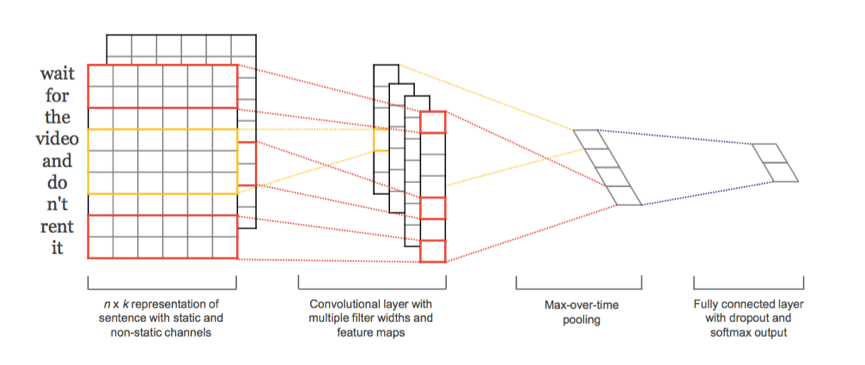比赛链接实例
《 Convolutional Neural Networks for Sentence Class》论文链接
yoon kim 的《Convolutional Neural Networks for Sentence Classification》。(2014 Emnlp会议)
还有一下其他利用卷积神经网络的例子讲解
那个比赛就是对文本进行分类,一共五类
预处理是利用了nltk,gensim和pandas进行数据处理
其中pandas读取csv文本文件,这样就可以通过下标访问内容
nltk是对自然语言处理的一个很有用的库,pip 安装之后需要执行nltk.download()然后安装其数据库
然后这里用到了stopwords用来分词,还加入了标点符号分词,然后利用SnowballStemmer提取词的主干
代码用到了一个keras的序列处理的方法,会自动进行切割文本,当大于一定长度
然后用到了新的层Embedding,就是用来将一个词转化为n维向量,处理后一个长l的句子会变成 l*n 的矩阵,每一行代表一个单词
然后用一维的序列卷积,注意其实是长度为n的二维卷积,图像的2d卷积其实是加上维度的3维卷积,这点需要注意
下面是代码,也不难,注释掉的部分是用lstm实现的效果也差不多,在那个比赛均能达到0.62的准确度
import numpy as np
import pandas as pd
from gensim import corpora
from nltk.corpus import stopwords
from nltk.tokenize import word_tokenize
from nltk.stem import SnowballStemmer
import keras
from keras.preprocessing import sequence
from keras.utils import np_utils
from keras.models import Sequential
from keras.models import Model
#from keras.layers import Dense, Activation, Convolution2D, MaxPooling2D, Flatten
from keras.layers import *
from keras.optimizers import Adam
from keras import callbacks
from keras import backend as K
from keras import metrics
from keras import regularizers
np.random.seed(0)
if __name__ == "__main__":
#load data
train_df = pd.read_csv('./data/train.tsv', sep='\t', header=0)
test_df = pd.read_csv('./data/test.tsv', sep='\t', header=0)
raw_docs_train = train_df['Phrase'].values
raw_docs_test = test_df['Phrase'].values
sentiment_train = train_df['Sentiment'].values
num_labels = len(np.unique(sentiment_train))
#text pre-processing
stop_words = set(stopwords.words('english'))
stop_words.update(['.', ',', '"', "'", ':', ';', '(', ')', '[', ']', '{', '}'])
stemmer = SnowballStemmer('english')
print stemmer
print "pre-processing train docs..."
processed_docs_train = []
for doc in raw_docs_train:
tokens = word_tokenize(doc)
filtered = [word for word in tokens if word not in stop_words]
stemmed = [stemmer.stem(word) for word in filtered]
processed_docs_train.append(stemmed)
print "pre-processing test docs..."
processed_docs_test = []
for doc in raw_docs_test:
tokens = word_tokenize(doc)
filtered = [word for word in tokens if word not in stop_words]
stemmed = [stemmer.stem(word) for word in filtered]
processed_docs_test.append(stemmed)
print len(processed_docs_train),len(processed_docs_test)
processed_docs_all = np.concatenate((processed_docs_train, processed_docs_test), axis=0)
print len(processed_docs_all)
dictionary = corpora.Dictionary(processed_docs_all)
dictionary_size = len(dictionary.keys())
print "dictionary size: ", dictionary_size
#dictionary.save('dictionary.dict')
#corpus = [dictionary.doc2bow(doc) for doc in processed_docs]
print "converting to token ids..."
word_id_train, word_id_len = [], []
for doc in processed_docs_train:
word_ids = [dictionary.token2id[word] for word in doc]
word_id_train.append(word_ids)
word_id_len.append(len(word_ids))
word_id_test, word_ids = [], []
for doc in processed_docs_test:
word_ids = [dictionary.token2id[word] for word in doc]
word_id_test.append(word_ids)
word_id_len.append(len(word_ids))
seq_len = np.round((np.mean(word_id_len) + 2*np.std(word_id_len))).astype(int)
print seq_len,np.mean(word_id_len),2*np.std(word_id_len)
#pad sequences
word_id_train = sequence.pad_sequences(np.array(word_id_train), maxlen=seq_len)
word_id_test = sequence.pad_sequences(np.array(word_id_test), maxlen=seq_len)
y_train_enc = np_utils.to_categorical(sentiment_train, num_labels)
# #LSTM
# print "fitting LSTM ..."
# # model = Sequential()
# # model.add(Embedding(dictionary_size, 128, dropout=0.2))
# # model.add(LSTM(128, dropout_W=0.2, dropout_U=0.2))
# # model.add(Dense(num_labels))
# # model.add(Activation('softmax'))
# seq_len=12
# dictionary_size=10000
# num_labels=10
myInput=Input(shape=(seq_len,))
print myInput.shape
WORD_VECSIZE=128
x = Embedding(output_dim=WORD_VECSIZE, input_dim=dictionary_size,dropout=0.2)(myInput)
print x.shape
filterNum=64
b=Conv1D(filterNum/2, 2)(x)
c=Conv1D(filterNum/4, 3)(x)
d=Conv1D(filterNum/4, 4)(x)
e=Conv1D(filterNum/4, 5)(x)
f=Conv1D(filterNum/8, 6)(x)
# b=Conv1D(filterNum/8, 2)(x)
# c=Conv1D(filterNum/4, 3)(x)
# d=Conv1D(filterNum/4, 4)(x)
# e=Conv1D(filterNum/2, 5)(x)
# f=Conv1D(filterNum, 6)(x)
ba=Activation('relu')(b)
ca=Activation('relu')(c)
da=Activation('relu')(d)
ea=Activation('relu')(e)
fa=Activation('relu')(f)
print ba.shape,fa.shape
b2=MaxPooling1D(pool_size=(seq_len -1 ))(ba)
c2=MaxPooling1D(pool_size=(seq_len -2 ))(ca)
d2=MaxPooling1D(pool_size=(seq_len -3 ))(da)
e2=MaxPooling1D(pool_size=(seq_len -4 ))(ea)
f2=MaxPooling1D(pool_size=(seq_len -5 ))(fa)
fb=Flatten()(b2)
fc=Flatten()(c2)
fd=Flatten()(d2)
fe=Flatten()(e2)
ff=Flatten()(f2)
all_flatten=concatenate([fb,fc,fd,fe,ff])
# flatten=Flatten()(all_pool)
dp=Dropout(0.5)(all_flatten)
# fc1=Dense(64,activation='relu')(dp)
# dp2=Dropout(0.5)(fc1)
out=Dense(num_labels,activation='softmax',kernel_regularizer=regularizers.l2(0.005))(dp)
# out=Dense(NUM_CLASS,activation='softmax')(dp)
model = Model(inputs=myInput,outputs=out)
model.compile(optimizer='adam',
loss='categorical_crossentropy',
# metrics=['accuracy',metrics.categorical_accuracy])
metrics=['accuracy'])
model.fit(word_id_train, y_train_enc, nb_epoch=5, batch_size=256, verbose=1)
test_pred = model.predict(word_id_test)
test_pred=test_pred.tolist()
test_label =[i.index(max(i)) for i in test_pred]
#make a submission
test_df['Sentiment'] = np.array(test_label).reshape(-1,1)
header = ['PhraseId', 'Sentiment']
test_df.to_csv('./lstm_sentiment.csv', columns=header, index=False, header=True)后面我又参考《A C-LSTM Neural Network for Text Classification》(arXiv preprint arXiv)这篇文章改了一下,在cnn后面加上了lstm,发现效果和原来差不多。上涨了0.001.。
模型差不多,就加了一层lstm
myInput=Input(shape=(seq_len,))
print myInput.shape
WORD_VECSIZE=128
x = Embedding(output_dim=WORD_VECSIZE, input_dim=dictionary_size)(myInput)
print x.shape
filterNum=128
b=Conv1D(filterNum/2, 2)(x)
c=Conv1D(filterNum/2, 3)(x)
d=Conv1D(filterNum, 4)(x)
e=Conv1D(filterNum, 5)(x)
f=Conv1D(filterNum, 6)(x)
# b=Conv1D(filterNum/8, 2)(x)
# c=Conv1D(filterNum/4, 3)(x)
# d=Conv1D(filterNum/4, 4)(x)
# e=Conv1D(filterNum/2, 5)(x)
# f=Conv1D(filterNum, 6)(x)
ba=Activation('relu')(b)
ca=Activation('relu')(c)
da=Activation('relu')(d)
ea=Activation('relu')(e)
fa=Activation('relu')(f)
b2=MaxPooling1D(pool_size=(seq_len -1 ))(ba)
c2=MaxPooling1D(pool_size=(seq_len -2 ))(ca)
d2=MaxPooling1D(pool_size=(seq_len -3 ))(da)
e2=MaxPooling1D(pool_size=(seq_len -4 ))(ea)
f2=MaxPooling1D(pool_size=(seq_len -5 ))(fa)
print b2.shape,f2.shape
all_pool=concatenate([b2,c2,d2,e2,f2])
# flatten=Flatten()(all_pool)
# print all_pool.shape
# res=Reshape(1)
# print type(res),type(all_flatten)
lstm=LSTM(128,return_sequences=True)(all_pool)
print lstm.shape
flatten=Flatten()(lstm)
dp=Dropout(0.5)(flatten)
# fc1=Dense(64,activation='relu')(dp)
# dp2=Dropout(0.5)(fc1)
out=Dense(num_labels,activation='softmax',kernel_regularizer=regularizers.l2(0.005))(dp)
# out=Dense(NUM_CLASS,activation='softmax')(dp)
model = Model(inputs=myInput,outputs=out)
model.compile(optimizer='adam',
loss='categorical_crossentropy',
# metrics=['accuracy',metrics.categorical_accuracy])
metrics=['accuracy'])





















 1070
1070











 被折叠的 条评论
为什么被折叠?
被折叠的 条评论
为什么被折叠?








